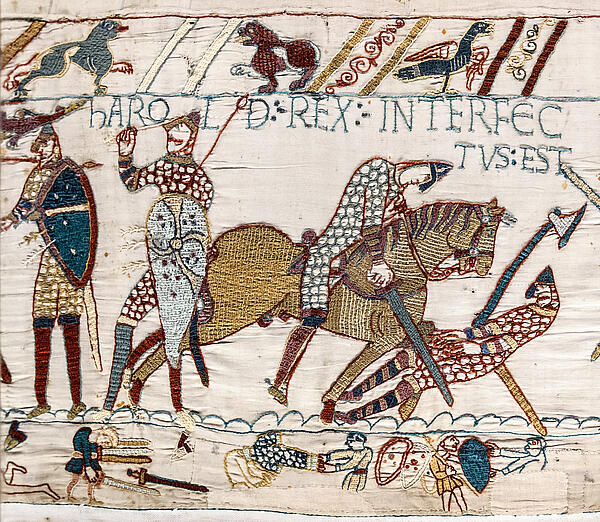Harold of Wessex
King Harold of Wessex led the English army into battle against William the Conqueror in 1066 at the Battle of Hastings, which was fought to decide who should become king after the death of Edward the Confessor.
Harold’s father, Godwin of Wessex, was the most powerful nobleman in England. In 1046 Harold became the Earl of East Anglia and also got a share of his brother Sweyn's lands when Sweyn was sent into exile in the same year. When Godwin was exiled in 1051, Harold went to Ireland where he stayed with the Dermont, King of Leinster. In 1052 Harold returned to England at the same time as his father. Godwin got back all that he lost when he had been sent into exile. He died in 1053 and Harold succeeded him as Earl of Wessex. After this Harold was a loyal supporter of Edward the Confessor.
In 1063, Harold led an English army into Wales - a country who had never been very respectful of England’s power. It was reported that his army killed every adult Welsh male they encountered. His fearsome campaign left sections of Wales depopulated.

When he was not away campaigning, Harold married Eadgyth Swanneck and they had five children. He also wanted to create a place to learn which is the reason he funded the creation of a large church in Waltham which had a chancellor, a dean and 12 canons. Chancellor Adelard of Liege was famous for his lectures.
Harold was shipwrecked on the coast of Ponthieu in 1064. William of Normandy insisted the Duke of Ponthieu, Guy, handed Harold over. Harold then went to Rouen with William and joined him in battle. It was after one particular battle against Conan of Brittany that Harold supposedly promised William he would support William's claim to the throne of England on the death of Edward. With this 'promise', William gave permission for Harold to head back to England. When Harold returned, he stated that the 'promise' had been forced out of him. If he had not made it, he would have spent the rest of his life as a captive in Normandy. So his conclusion was that this type of 'promise' had no legal backing.
Edward died on 5 January 1066. On 6 January, the Witan met to decide who should replace Edward as he left no heir to the throne. The Witan consisted of 60 of England's most powerful nobles and together they decided Harold should be England’s new king. It is widely believed that Harold somehow grasped the English throne but it was actually offered to him by the Witan. The Witan had discussed the merits of other candidates: William of Normandy, Harold Hardrada of Norway and Edgar Etheling. Harold was chosen out of these four potentials.
Harold was killed at the Battle of Hastings on 15 October. The Bayeux Tapestry shows him having an arrow inserted in the eye. It will never be known for certain how Harold died but it is most unlikely that a king of England would have been on foot armed with a spear - as the tapestry shows.
After the battle ended, Harold's mother, Gytha, asked William to bring Harold's body to her for a proper burial. She offered William Harold's weight in gold, but he refused. He was convinced that Harold had broken a sacred oath and that he should pay for it - even though he was no longer alive.
Harold's body is reportedly buried on the beach at Pevensey Bay, on the shores he had tried to defend. William ensured that by doing this, Harold was not buried in a Christian way. Some people believe that his body was eventually buried at the church he had established at Waltham.
See also:
The Bayeux Tapestry Depicting The Battle of Hastings Scene By Scene
MLA Citation/Reference
"Harold of Wessex". HistoryLearning.com. 2026. Web.
Key facts
| Name: | Harold of Wessex or Harold Godwinson |
| Birth Date: | 1022, Wessex |
| Death: | 1066, |
| Coronation: | 6 January 1066 |
| Reign: | 5 January - 14 October 1066 |
| Predecessor: | Edward the Confessor |
| Successor: | Edgar II |
